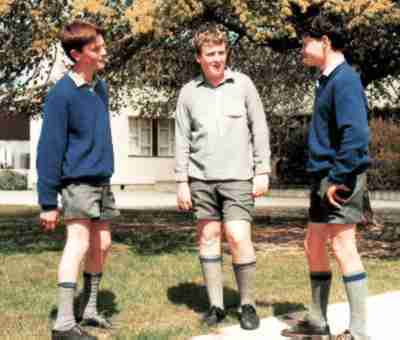
Figure 1.--These New Zealand schoolboys are wearing grey Rugby-style shirts. Two of the boys are wearing jumpers over their shirts. Note that this type of shirt normally has a chest pocket. |

|
A discussion of shirts today is a bit different than at the turn of the century. This was because collars today are an intergal of a shirt. At the tirn of the century many men and boys wore shirt waists with detachable collars. English school uniforms was for years dominated by the Eton collar. The standard school boy shirt in England after Eton collars finally disappeared during the 1930s were grey shirts with soft straight collars. In an era when wash was more labor intensive, grey shirts were more practical
for active schoolboys than whiter shirts. For dress occasions white shirt was substituted. Some elementary schools in recent years have intoduced more casual white or blue polo-style shirts. The main style in the 1950s for grey shirts was of a rugby type i.e. the buttons only came half way down the front and were made out of cotton. Many preparatory schools allowed Aertex shirts in the 1950s of grey, white or blue for summer wear. Aertex fabric is rather similar to the material in a cellular vest; small holes to allow for ventilation in hot weather. Ties were not normally worn these shirts.
Actual shirts or as they were often called at the turn ofthe 20th century, shirt waists, were of little importance in the development of school uniform during the last half of the 19th century. Except for France which had inroduced smocks in the 1870s, England was the only country where many boys wore uniforms. Almost always the uniform involved covering up the shirt. Rarely would boys go to school in their short sleeves. Even boys at state schools where uniforms were not required, with the exception of a cap, would dress similarly. All that was visible would be the collar--and the collar that predominated would be the Eton collar. Younger boys might wear lace collars. The senior boys at many public (private secondary) schools in England after the turn of the 20th century were allowed to wear more adult looking rounded collars. Interestingly the button down shirt collar developed at first for polp players, has never been worn for school uniforms. Almost always the collar of a school uniform shirt is a plain collar.
The standard school boy shirt in England after Eton suits disappeared during the 1930s were grey shirts with soft straight collars. In an era when wash was more labor intensive, grey shirts were more practical for active schoolboys than whiter shirts. For dress occasions white shirt was substituted. Some elementary schools in recent years have intoduced more casual white or blue polo-style shirts. The main style in the 1950s for grey shirts was of a rugby type i.e. the buttons only came half way down the front and were made out of cotton. Many preparatory schools allowed Aertex shirts in the 1950s of grey, white or blue for summer wear. Aertex fabric is rather similar to the material in a cellular vest; small holes to allow for ventilation in hot weather. Ties were not normally worn these shirts.
Blouses are also commonly worn to school. A blouse is a shirt-like garment, but with out tails to tuck into the waistband of skirts or pants. Blouses are today a standard school garment for girls. In the 19th and early 20th century they were also commonly worn by boys as well. Boys commonly wore blouses to primary school until about Wold War I (1914-18). Blouses were made for boys to avout 12 years of age.
Related Chronolgy Pages in the Boys' Historical Web Site
[The 1880s]
[The 1930s]
[The 1940s]
[The 1930s]
[The 1940s]
[The 1950s]
[The 1960s]
[The 1970s]
[The 1980s]
Related Style Pages in the Boys' Historical Web Site
[Long pants suits]
[Short pants suits]
[Socks]
[Eton suits]
[Jacket and trousers]
[Blazer]
[School sandals]
Navigate the HBC School Section:
[Return to Main school uniform page]
[Return to Main school uniform garment page]
[About Us]
[Activities]
[Chronology]
[Clothing styles]
[Countries]
[Debate]
[Economics]
[Garment]
[Gender]
[Hair]
[History]
[Home trends]
[Literary characters]
[School types]
[Significance]
[Transport and travel
[Uniform regulations]
[Year level]
[Other topics]
[Images]
[Links]
[Registration]
[Search]
[Tools]
[Return to the Historic Boys' School Home]
